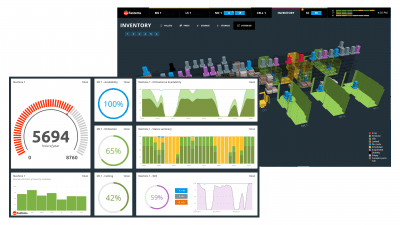Did you know that the story of Fastems’ Manufacturing Management Software (MMS) started already more than 20 years ago? The first version, MMS 1.0, was launched in 1999. Since then, the features and coverage of different automation scenarios of the software have evolved remarkably. There have been many turning points in the history of MMS: developing part handling automation alongside pallet handling, generational changes in the software where the latest generation introduced the predictive and adaptive production, and resource management. In 2019 a new ground-breaking domain “Work Cell Operations” was introduced. The MMS product family includes already millions of lines of code, and there are already more than 2000 automation system installations globally.
The MMS plays a vital role at Fastems and has become the heart of the company’s intelligent factory automation solutions. Because of this, Fastems has also invested in talent and working habits. Today, approximately 25% (~ 120 persons) of Fastemsians work with software related tasks such as UI & UX, business logic design, robotic software programming, interfaces and integration, device control design (PLC), IoT connectivity, and remote support technology.
 Software Development at Fastems
Software Development at Fastems
In general, Fastems delivers +200 software projects annually and 130 of them are tailored to meet customer requirements. Fastems also has its dedicated software development team for the MMS product family and platform, which is led by Pasi Kauhanen, the Head of Software Platform Development. Pasi has been involved in the MMS development since the MMS 1.0 was being designed and created. He started as a developer and has had various roles among the MMS development during his 25 years at Fastems, which can be seen in the strong vision and development of the MMS product families.
Today, according to Pasi, the key drivers behind the development of MMS are having a customer-centric approach, UI & UX development, agile development, version management, code reviews and CI & automated testing. Currently, the team’s main tasks are to maintain and develop the MMS Software platform known as “MMS Vanilla”, version management, develop working methods and quality improvements.
Some years ago, Fastems adopted widely agile development methods in the software supply. At Fastems, agile means that people are spread out into teams that work independently. They have Scrum and Kanban boards for managing tasks and sprints that include planning, reviews & retrospectives. Each Scrum team has their own daily status checkup meetings to go through any work-related issues or questions there might be.
Jari Kalliomäki, the Scrum Master of the MMS development team, thinks highly of the Scrum methods: “Software development at Fastems was already high-quality even before Scrum was introduced to the team. However, it has had a substantial impact on the way we do things now. Thanks to Scrum methods, we work more as a team and have clear joint targets in every sprint instead of having individuals who develop purely their own projects solo. By having joint targets, communication increases naturally. One of the pros of the Scrum methods is that it is possible to react fast to possible changes. This is because after every sprint we go over the latest changes in the software and make needed adjustments before the next sprint is started.”
How an Idea or Customer Need Become a Line of Code
According to Pasi, a good-quality backlog is the cornerstone of the agile development of MMS. The backlog includes all the feedback, ideas and desires that our customers and Fastemsians have given regarding new feature wishes and other development requests. The backlog items are directly or closely related to true customer needs, which are gathered and processed actively. Sometimes even direct and singular customer wishes can be developed through the generic platform development if the request is seen to benefit the majority of customers and users. Consequently, the feedback is crucial and much valued.
The backlog is organized and prioritized regularly, and top backlog items are shifted to the Kanban and Scrum boards for further development.
Three Top Reasons Why Your MMS Should Be Updated and Systems Modernized
Honestly speaking, it is common and maybe a bit too easy to ignore software updates. Once the investment has been made, the focus is on manufacturing and hardware, and the maintenance of the software is easily forgotten. Please have a look at these points that highlight why software updates should be part of the lifecycle planning and service management:
- Simply said, MMS is like any information system – it requires updates because IT technology is developing and evolving rapidly, and the information systems of production are no exception. They can’t be kept outside of that development.
- MMS is integrated to other IT systems in the company, which makes updates crucial in terms of keeping the entire architecture, or the so-called the ensemble of the programs functional and flawless. By doing this, IT risks can be managed and production can be kept running from the information system point of view.
- MMS is being developed daily. Fastems’ dedicated software development team constantly aims to release new features and improvements that help customers improve business and manufacturing. With the MMS software updates, customers can keep their factories contemporary and make sure productivity is maximized through modern and efficient processes. New ways of managing and leading production help companies stay flexible and competitive.
Luckily, keeping MMS up-to-date is made easy with Fastems Software (SW) maintenance service,” explains Janne Kivinen, Product Manager at Fastems. “With the SW maintenance contract, our customers can ensure they have the latest MMS version installed on a regular basis. These kinds of incremental and constant updates make sure that systems stay up to date, which in turn guarantees high performance now and in the future.”